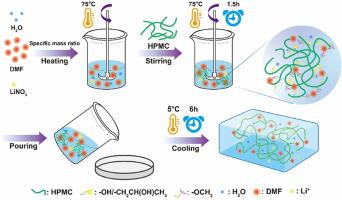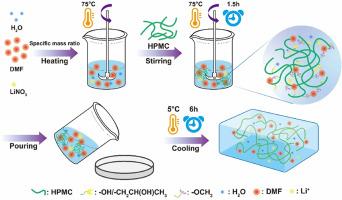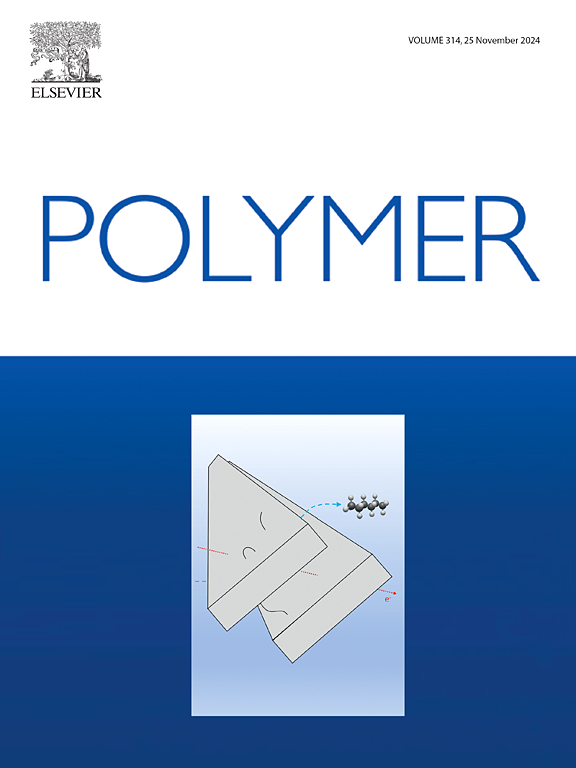单锅合成用于高性能超级电容器的羟丙基甲基纤维素凝胶聚合物电解质
IF 4.1
2区 化学
Q2 POLYMER SCIENCE
引用次数: 0
摘要
电解质是显著影响超级电容器电化学性能的关键成分。本研究采用创新的 "一锅法 "合成了具有高工作电压的羟丙基甲基纤维素(HPMC)基凝胶聚合物电解质(GPE),并系统研究了有机溶剂/水比例和LiNO3浓度对GPE凝胶化和电导率的影响。在DMF/水比为10:0、掺入7%的LiNO3的最佳条件下,离子电导率达到了1.06 S m-1。在 1.0 A g-1 时,其比电容为 115.8 F g-1,能量密度为 29.31 Wh kg-1,并且具有出色的循环稳定性,在循环 2000 次后仍能保持 86% 的初始电容。通过压力条件下的循环稳定性测试,组装后的柔性超级电容器能够保持 60% 的电容保持率和 97% 的库仑效率。这项研究提供了一种具有优异电化学特性的基于 HPMC 的 GPE 的简化合成方法,展示了其在推动柔性电子产品超级电容器技术发展方面的潜力。本文章由计算机程序翻译,如有差异,请以英文原文为准。


One-pot synthesis of hydroxypropyl methylcellulose-based gel polymer electrolytes for high-performance supercapacitors
The electrolyte is a crucial component that significantly affects the electrochemical performance of supercapacitors. The hydroxypropyl methylcellulose (HPMC)-based gel polymer electrolyte (GPE) with high operating voltage was synthesized via an innovative “one-pot” method in this study, and the impacts of organic solvent/water ratio and LiNO3 concentration on gelation and conductivity of the GPE were investigated systematically. Under the optimal condition with a DMF/water ratio of 10:0 and the incorporation of 7 % LiNO3, the ionic conductivity reached 1.06 S m−1. Integrated into symmetric supercapacitors, the HPMC-based GPE demonstrated an expanded electrochemical window of 2.7 V. It also possessed a specific capacitance of 115.8 F g−1 at 1.0 A g−1, an energy density of 29.31 Wh kg−1, and outstanding cyclic stability, retaining 86 % of its initial capacitance after 2000 cycles. Through cyclic stability tests under pressure conditions, the assembled flexible supercapacitors were able to maintain capacitance retention of 60 % and coulombic efficiency of 97 %. This work offers a streamlined synthesis for HPMC-based GPE with superior electrochemical properties, which exhibits its potential in advancing supercapacitor technology for flexible electronics.
求助全文
通过发布文献求助,成功后即可免费获取论文全文。
去求助
来源期刊

Polymer
化学-高分子科学
CiteScore
7.90
自引率
8.70%
发文量
959
审稿时长
32 days
期刊介绍:
Polymer is an interdisciplinary journal dedicated to publishing innovative and significant advances in Polymer Physics, Chemistry and Technology. We welcome submissions on polymer hybrids, nanocomposites, characterisation and self-assembly. Polymer also publishes work on the technological application of polymers in energy and optoelectronics.
The main scope is covered but not limited to the following core areas:
Polymer Materials
Nanocomposites and hybrid nanomaterials
Polymer blends, films, fibres, networks and porous materials
Physical Characterization
Characterisation, modelling and simulation* of molecular and materials properties in bulk, solution, and thin films
Polymer Engineering
Advanced multiscale processing methods
Polymer Synthesis, Modification and Self-assembly
Including designer polymer architectures, mechanisms and kinetics, and supramolecular polymerization
Technological Applications
Polymers for energy generation and storage
Polymer membranes for separation technology
Polymers for opto- and microelectronics.
 求助内容:
求助内容: 应助结果提醒方式:
应助结果提醒方式:


